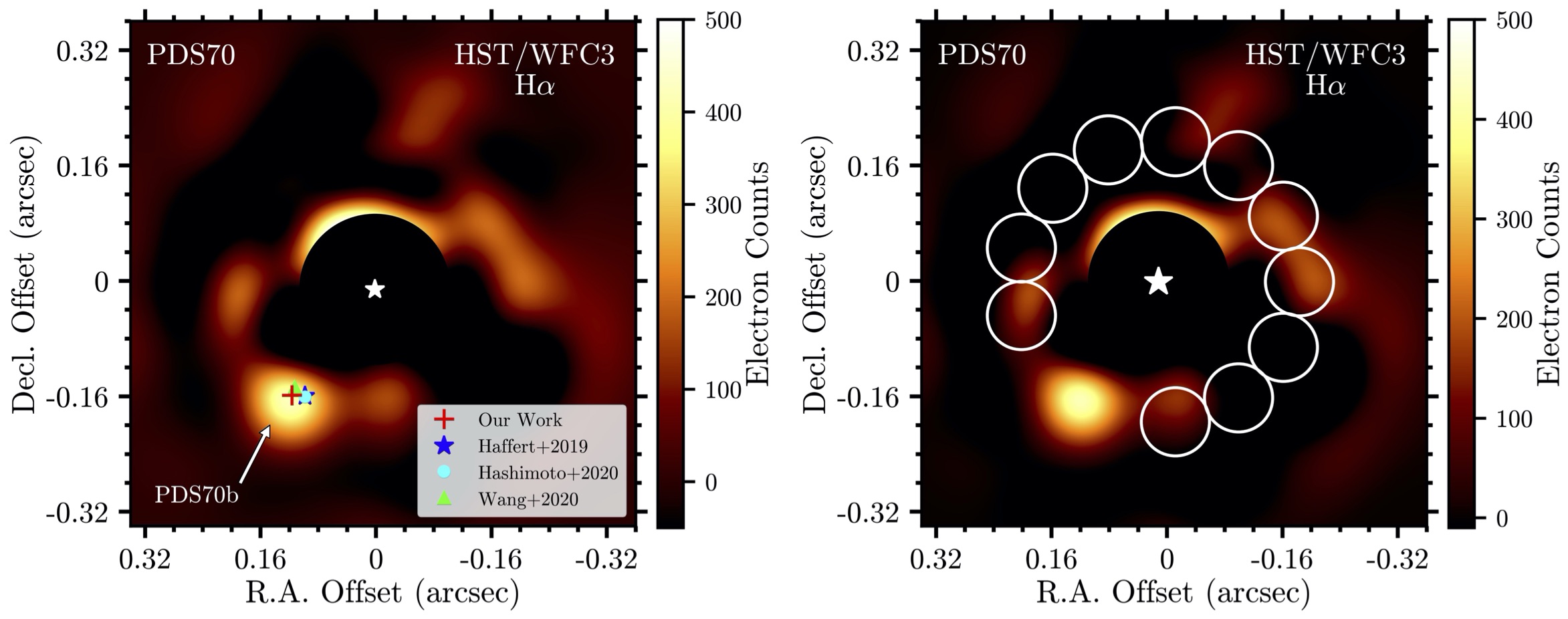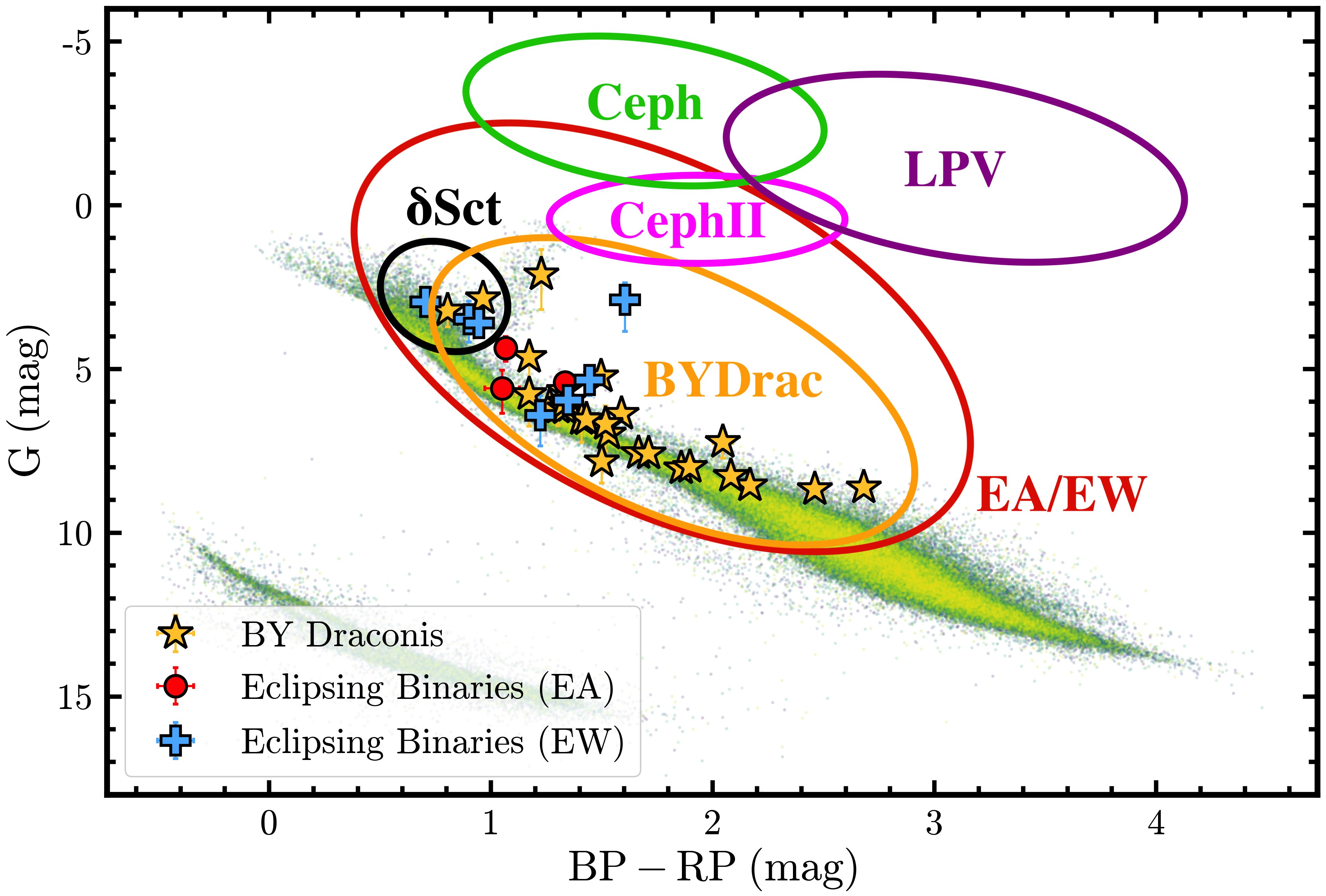SUPER-RDI: Improving Exoplanet Detection Limits at Small Angular Separations with the Keck/NIRC2 Imager
Aniket Sanghi, Jason Wang, Jerry Xuan, Dimitri Mawet
Details coming soon!Reference Star Differential Imaging of the PDS 70 Planetary System using the HST/WFC3 Archival PSF Library
Aniket Sanghi, Yifan Zhou, Brendan Bowler
Over the past two decades, high contrast imaging techniques have enabled the direct detection and characterization of exoplanets. One of the central goals of current and future high-contrast imaging programs is to directly probe the process of planet formation. Ongoing planet formation processes have been observed in young planetary systems with actively accreting protoplanets, such as the PDS 70 planetary system. In this system, planets are growing by attracting material with their gravity in a process called accretion. The accreted gas falls onto the planet at a high velocity and heats up the planet’s atmosphere, creating an accretion shock front (see image below; Credit: Yifan Zhou, Univ. of Texas at Austin). This shock is so hot that it generates energetic hydrogen line emission. By measuring the strength of the line emission, we can determine the planet’s mass accretion rate, which is an essential constraint on its formation and early evolution. Presently, discoveries of such protoplanets with direct imaging are extremely scarce.
To enable the discovery of a greater number of protoplanets, achieving high instrument sensitivity to detect faint planets at smaller separations from their bright host star is imperative. Angular differential imaging (ADI), the most commonly used observing technique to directly image exoplanets, suffers from significant self-subtraction of the planet signal at close separations, limiting our detection sensitivity. Further, for space-based observatories, ADI significantly complicates the planning of observations. In contrast, reference star differential imaging (RDI) is a mechanically easier observing strategy that enables direct imaging of planets at small separations without the limitation of self-subtraction. It utilizes reference stars distinct from the science target to build a model of the target star’s starlight for subtraction.
We demonstrate the applicability of reference star differential imaging to images of the PDS 70 planetary system, taken with the Hubble Space Telescope’s Wide Field Camera 3, to detect one of the protoplanets – PDS 70 b. We utilize reference star images selected from the Hubble Space Telescope’s publicly available Point Spread Function (PSF) Library based on a morphology-significance criterion. Under this criterion, reference stars with sharp and symmetric PSFs are chosen. This selection improved the quality of our primary subtraction and enabled the detection of PDS 70 b. Crucially then, our work demonstrates that the Hubble Space Telescope can directly image exoplanets at high contrasts and close separations to study the process of planet formation. This technique can be expanded to observe stars similar to PDS 70 and has the potential to significantly increase the total number of accreting protoplanet discoveries.

Identifying Periodic Variable Stars and Eclipsing Binary Systems with Long-Term Las Cumbres Observatory Photometric Monitoring of ZTF J0139+5245
Aniket Sanghi, Zachary Vanderbosch, Michael Montgomery
First-Author Paper
We present the results of our search for variable stars using the long-term Las Cumbres Observatory (LCO) monitoring of white dwarf ZTF J0139+5245 with the two 1.0-m telescope nodes located at McDonald Observatory using the Sinistro imaging instrument. In this search, we find 38 variable sources, of which 27 are newly discovered or newly classified (71%) based on comparisons with previously published catalogs, thereby increasing the number of detections in the field-of-view under consideration by a factor of ≈ 2.5. We find that the improved photometric precision per-exposure due to longer exposure time for LCO images combined with the greater time-sampling of LCO photometry enables us to increase the total number of detections in this field-of-view. Each LCO image covers a field-of-view of 26'x26' and observes a region close to the Galactic plane (b=-9.4∘) abundant in stars with an average stellar density of ≈8 arcmin^-2. We perform aperture photometry and Fourier analysis on over 2000 stars across 1560 LCO images spanning 537 days to find 28 candidate BY Draconis variables, 3 candidate eclipsing binaries of type EA, and 7 candidate eclipsing binaries of type EW. In assigning preliminary classifications to our detections, we demonstrate the applicability of the Gaia color-magnitude diagram (CMD) as a powerful classification tool for variable star studies.
Measuring the Substellar IMF using a 25-pc Volume Limited Sample of L0-T8 Brown Dwarfs
William Best, Aniket Sanghi, Michael Liu, Eugene Magnier, Trent Dupuy
Brown dwarfs cool continuously through their lifetimes implying a degeneracy in spectral type and luminosity for different combinations of mass and age. This makes it difficult to utilize observables from photometry and spectroscopy to determine physical properties such as mass, age, metallicity etc., hindering our understanding of a brown dwarf’s evolutionary path. A statistical approach that can overcome this challenge is to model populations of brown dwarfs characterized by an initial mass function (IMF), a birth history, and an evolutionary model.Our project measures the substellar IMF using a 25-pc volume limited sample of 369 L0-T8 brown dwarfs defined entirely by parallaxes. We constrain the index alpha of the power-law IMF using the exponential age distribution and the Besançon Galaxy Model (BGM) of the solar neighborhood through a chi-square goodness-of-fit test utilizing the hybrid evolutionary models of Saumon & Marley (SM08) and the COND evolutionary models. We present the strongest substellar IMF constraints to date, finding a strong preference for a positive value of alpha, i.e., an average lower mass population of brown dwarfs in the solar neighborhood. We obtain consistent values of alpha for SM08 and COND, indicating that the uncertainties on our constraints have not been underestimated.
Visualizing the Complex Roots of Quadratic and Cubic Polynomial Functions in Three Dimensions
Aniket Sanghi
Accepted to The College Mathematics Journal, The Mathematical Association of America
Finding the roots of functions is central to the study of their behavior. Complex roots, in particular, hold importance in topics such as circuit theory and signal processing. Given any function in the co-ordinate plane, the points at which it intersects the x-axis represent the real roots of the function. However, a function’s complex roots cannot be found by this approach. I deduced that these could be obtained graphically using a complex input. However, a 2D complex input results in a 2D complex output, requiring four-dimensions of space to represent the graph of the function. I developed a dimensionality reduction technique that utilizes the 2D complex input while restricting the output to 1D, i.e., to real numbers. This allows 3D graphical visualization of the complex roots of quadratic and cubic functions in MATLAB. My novel visualization method enhances classroom learning, stimulates original thinking, and offers unique perspectives on topics in undergraduate mathematics. This independent research work was accepted to The College Mathematics Journal, a peer-reviewed mathematics journal by the Mathematical Association of America.